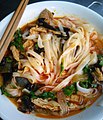Mì Quảng
 A bowl of Mì Quảng with pork and egg | |
| Type | Noodle |
|---|---|
| Course | Main course |
| Place of origin | Vietnam |
| Region or state | Quảng Nam Province |
| Associated cuisine | Vietnam |
| Serving temperature | Warm |
| Main ingredients | Rice noodles, shrimp or pork or chicken (sometimes fish or beef), various herbs |
| Ingredients generally used | Turmeric, peanuts, toasted sesame rice crackers, chili peppers, lime |
Mì Quảng (also spelled mỳ Quảng), literally "Quảng noodles", is a Vietnamese noodle dish that originated in Quảng Nam Province in central Vietnam. It is one of the region's most popular and well-recognized food items, and is served on various occasions, such as at family parties, death anniversaries, and Tết. It is a common food item in Ðà Nẵng and the surrounding regions, where it is eaten at any time of day.[1]
Ingredients and serving
[edit]The main ingredients of mì Quảng are rice noodles, meat, and herbs, most commonly served with a small amount of broth, which is generally infused with turmeric. Peanut oil can also be added to make the dish more flavorful.[2] Wide rice noodles are placed atop a bed of fresh herbs in a bowl (or vice versa), and then warm or lukewarm broth and meat are added. The broth is usually strongly flavored and only a small amount of it is used, generally enough to partially cover the vegetables.[3]
Meats used in the dish may include one or more of the following: shrimp (tôm), pork (thịt heo), chicken (gà), or even fish (cá) or beef (bò). The broth is made by simmering the meat in water or bone broth for a more intense flavor, seasoned with fish sauce, black pepper, shallot and garlic. Turmeric is often added to the broth, giving it a yellowish color.[3][4]
As with many Vietnamese dishes, mì Quảng is served with fresh herbs (rau); commonly used herbs include Thai basil, cilantro (ngò or rau mùi), scallions or onion leaves, Vietnamese coriander (rau răm), sliced banana flower (bắp chuối bào), and lettuce. A variety of other herbs may also be used in mì quảng, including common knotgrass (rau đắng), water mint (rau húng lủi), perilla (rau tía tô), and heartleaf (rau diếp cá).[3][4][5]
Mì Quảng is commonly garnished with peanuts and toasted sesame rice crackers called bánh tráng mè, which sets the dish apart from other noodle dishes. Additional ingredients may include hard-boiled quail eggs, steamed pork sausage (chả), or shredded pork rinds (tóp mỡ). Lime juice and fresh chili peppers are often used as an added seasoning; other seasonings may include soy sauce or chili sauce.[3][4][5]
Mì Quảng can also be served without broth, as a salad (mì Quảng trộn).[6]
-
Served with pork, shrimp and toasted bánh tráng mè
-
Served with pork, shrimp and yellow turmeric-dyed noodles
-
Served with pork, shrimp and prawn crackers (bánh phồng tôm)
-
Served with snakehead fish (cá lóc)
-
Vegetarian mì Quảng with imitation meat
Cultural aspects
[edit]There is a Vietnamese saying about this dish:[7][8]
Thương nhau múc bát chè xanh,
Làm tô mì Quảng mời anh xơi cùng.
This couplet describes a girl from Quảng Nam, a province on Vietnam's South Central Coast, who warmly invites her lover to drink a cup of tea and a bowl of mì Quảng, to show him the depth of her love for him.
See also
[edit]Notes
[edit]- ^ Le, Helen (29 February 2012). "Mi Quang - Quang Noodle with Pork and Shrimp". Helen’s Recipes Official Website. Retrieved 5 July 2024.
- ^ "Mì Quảng - 3 cách nấu SIÊU HẤP DẪN chuẩn vị miền Trung". vinpearl.com (in Vietnamese). Retrieved 2024-05-18.
- ^ a b c d Le, Helen (2014-08-01). "Quang-style noodle with pork and shrimp: Mỳ Quảng tôm thịt". Vietnamese Food with Helen's Recipes. Helen Le. pp. 25–27. ISBN 9781500529710.
- ^ a b c Hesser, Amanda (2010-10-25). "Mi Quang (Rice noodles with shrimp, herbs, and fried pork rinds)". The Essential New York Times Cookbook: Classic Recipes for a New Century. W. W. Norton & Company. pp. 609–611. ISBN 9780393247671.
- ^ a b Fay, Kim (2010). "Someone Else's Favorites". Communion: A Culinary Journey Through Vietnam. ThingsAsian Press. p. 137. ISBN 9781934159149.
- ^ Le, Helen (2017-10-03). "Quang-style noodle salad". Simply Pho: A Complete Course in Preparing Authentic Vietnamese Meals at Home. Race Point Publishing. p. 141. ISBN 9781631063701.
- ^ Nguyễn Hữu (2019). Làm tô mì Quảng mà thương nhau cùng. Thanh Nien News. 2019-02-01. Accessed 2024-01-13.
- ^ Tiêu Phong (2011). Ăn mì Quảng để nhớ quê nhà. VnExpress. 2011-12-15. Accessed 2024-01-13.
References
[edit]- Hesser, Amanda (2010-10-25). "Mi Quang (Rice noodles with shrimp, herbs, and fried pork rinds)". The Essential New York Times Cookbook: Classic Recipes for a New Century. W. W. Norton & Company. pp. 609–611. ISBN 9780393247671.
- Le, Helen (2014-08-01). "Quang-style noodle with pork and shrimp: Mỳ Quảng tôm thịt". Vietnamese Food with Helen's Recipes. Helen Le. pp. 25–27. ISBN 9781500529710.
- Le, Helen (2017-10-03). "Quang-style noodle salad". Simply Pho: A Complete Course in Preparing Authentic Vietnamese Meals at Home. Race Point Publishing. p. 141. ISBN 9781631063701.





